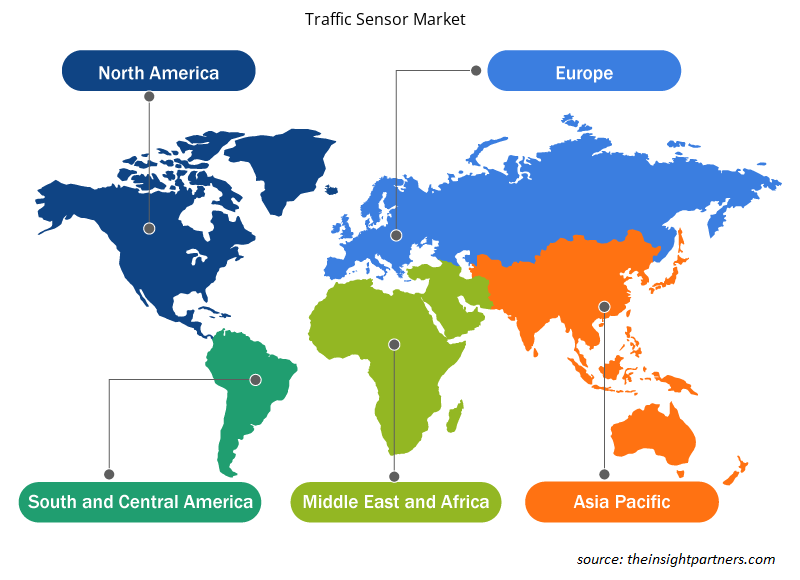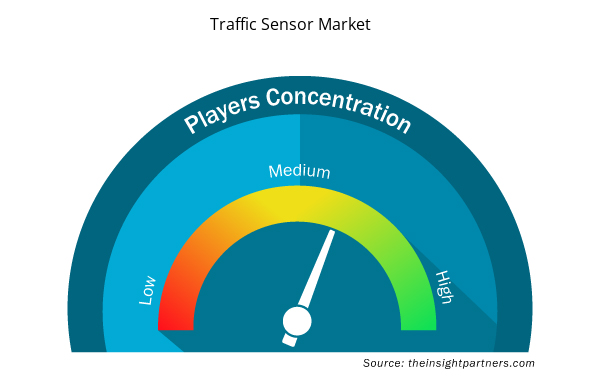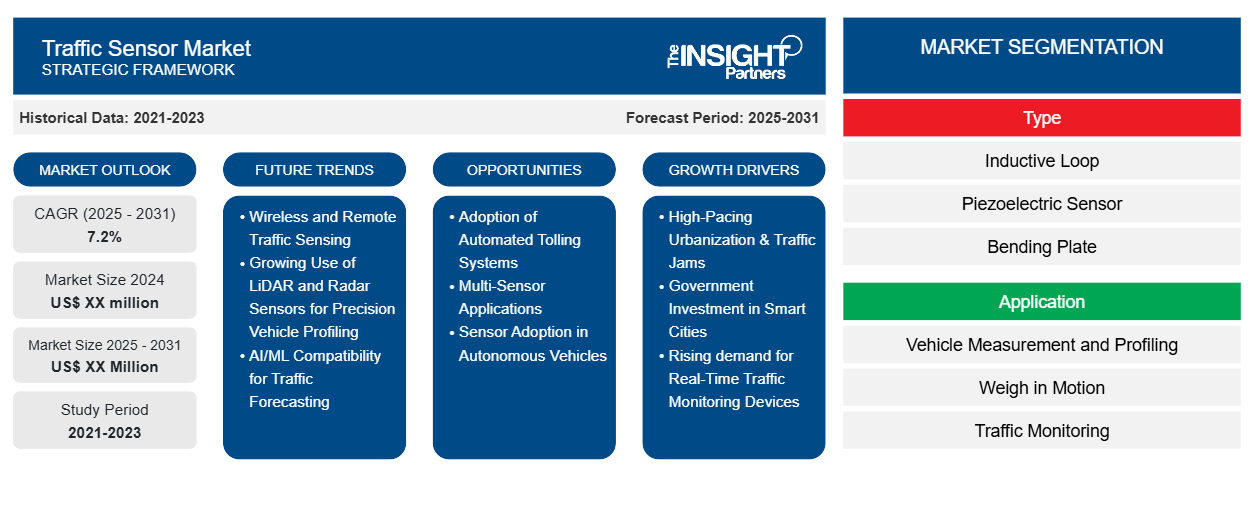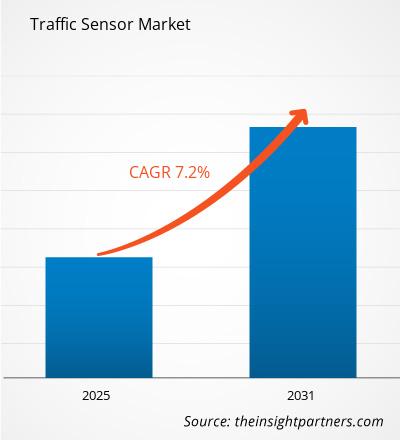Le marché des capteurs de trafic devrait enregistrer un TCAC de 7,2 % de 2024 à 2031, avec une taille de marché passant de XX millions USD en 2024 à XX millions USD d'ici 2031.
Rapport de recherche sur le marché des capteurs de trafic dans plusieurs sous-segments clés classés par type (boucle inductive, capteur piézoélectrique, plaque de pliage, capteur d'image, capteur infrarouge, capteur radar, capteur LiDAR, capteur magnétique, capteur acoustique, autres) et application (mesure et profilage de véhicules, pesée en mouvement, surveillance du trafic, péage automatisé). L'analyse globale est ensuite décomposée au niveau régional et par pays principaux. La taille du marché et les prévisions aux niveaux mondial, régional et national pour tous les segments de marché clés sont couvertes dans le cadre du périmètre. Le rapport offre la valeur en USD pour l'analyse, les segments, les régions et les pays ci-dessus. Il a prolongé les prévisions jusqu'en 2031 afin de fournir des développements futurs qui pourraient avoir un impact potentiel sur l'efficacité opérationnelle ainsi que sur la satisfaction des clients.
Objectif du rapport
Le rapport Traffic Sensor Market de The Insight Partners vise à décrire le paysage actuel et la croissance future, les principaux facteurs moteurs, les défis et les opportunités. Cela fournira des informations à diverses parties prenantes commerciales, telles que :
- Fournisseurs/fabricants de technologie : pour comprendre l’évolution de la dynamique du marché et connaître les opportunités de croissance potentielles, leur permettant de prendre des décisions stratégiques éclairées.
- Investisseurs : Effectuer une analyse complète des tendances concernant le taux de croissance du marché, les projections financières du marché et les opportunités qui existent tout au long de la chaîne de valeur.
- Organismes de réglementation : Réglementer les politiques et surveiller les activités du marché dans le but de minimiser les abus, de préserver la confiance des investisseurs et de maintenir l’intégrité et la stabilité du marché.
Segmentation du marché des capteurs de trafic
Taper
- Boucle inductive
- Capteur piézoélectrique
- Plaque de pliage
- Capteur d'images
- Capteur infrarouge
- Capteur radar
- Capteur LiDAR
- Capteur magnétique
- Capteur acoustique
- Autres
Application
- Mesure et profilage des véhicules
- Pesée en mouvement
- Surveillance du trafic
- Péage automatique
Personnalisez ce rapport en fonction de vos besoins
Vous bénéficierez d'une personnalisation gratuite de n'importe quel rapport, y compris de certaines parties de ce rapport, d'une analyse au niveau des pays, d'un pack de données Excel, ainsi que d'offres et de remises exceptionnelles pour les start-ups et les universités.
- Obtenez les principales tendances clés du marché de ce rapport.Cet échantillon GRATUIT comprendra une analyse de données, allant des tendances du marché aux estimations et prévisions.
Facteurs de croissance du marché des capteurs de trafic
- High-Pacing Urbanization & Traffic Jams: Cities are piled up in the number of cities' population, and along with high urbanization, they have already clogged city roads. In such cities, intelligent traffic management systems for congestion and smoother flow of traffic are in huge demand. We need the traffic sensors for real-time monitoring to help cities use data-driven decision on traffic management and infrastructure design.
- Government Investment in Smart Cities: All over the world, governments are formulating smart city programs to enhance cities' infrastructure and safety. The smart cities use traffic sensors to monitor and regulate the flow of traffic and also limit some accidents which may occur. This push toward smart cities will increase the demand for traffic sensors significantly.
- Rising demand for Real-Time Traffic Monitoring Devices: Since there has been a constant need to present real-time data to be applied to improve traffic flow and safety, the use of traffic sensors for traffic monitoring increased. It will help the government gather and process real-time traffic information to translate that information into real-time road project management, and automatically tolls on roads, and urban planning in general.
Traffic Sensor Market Future Trends
- Wireless and Remote Traffic Sensing: There are an increasing number of wireless traffic sensors that can transmit data live. These sensors can be installed easily at a low cost associated with physical wiring and infrastructure. Remote monitoring also enables authorities to monitor traffic data 24x7 and make real-time adjustments to traffic signals and control mechanisms.
- Growing Use of LiDAR and Radar Sensors for Precision Vehicle Profiling: The usage of LiDAR and Radar sensors for accurate vehicle profiling (weight, classification) is rising. These sensors are very accurate for vehicle type and speed, and so helpful for tolling and traffic monitoring applications. The market will grow due to the high requirement for precise vehicle measurement and LiDAR/radar sensors.
- AI/ML Compatibility for Traffic Forecasting: AI/ML Computing in combination with traffic sensors is driving predictive traffic analytics. Artificial intelligence systems can analyze live traffic information to predict congestion, signal timings, and traffic flow. This pattern is setting the stage for smarter and more adaptive traffic management in the world. This would be the future trends of the Traffic Sensor Market
Traffic Sensor Market Opportunities
- Adoption of Automated Tolling Systems: Automated tolling systems are gaining popularity worldwide, especially in heavy traffic zones. Traffic sensors enable these solutions by providing true time data of vehicle speeds, laden weight,s and so on, making tolling efficient and less crowded at toll gates. That is a huge market opportunity for sensor manufacturers to join the automated tolling trend.
- Multi-Sensor Applications: Traffic authorities are now installing multi-sensor applications for better traffic monitoring and management. By using multiple sensors (radar, LiDAR, infrared, etc) within the same system, you get full traffic information. This is the perfect scenario for sensor manufacturers to come up with complete integrated solutions that deliver traffic management, crash detection, and vehicle profiling.
- Sensor Adoption in Autonomous Vehicles: As autonomous cars are increasingly designed, accurate traffic and vehicle profiling are ever more important. Road sensors - notably LiDAR and radar sensors - are fundamental to ensuring that autonomous cars are not blind. Sensor firms can exploit this trend with sensors that integrate with ADAS.
Traffic Sensor Market Regional Insights
The regional trends and factors influencing the Traffic Sensor Market throughout the forecast period have been thoroughly explained by the analysts at Insight Partners. This section also discusses Traffic Sensor Market segments and geography across North America, Europe, Asia Pacific, Middle East and Africa, and South and Central America.

- Get the Regional Specific Data for Traffic Sensor Market
Traffic Sensor Market Report Scope
| Report Attribute | Details |
|---|---|
| Market size in 2024 | US$ XX million |
| Market Size by 2031 | US$ XX Million |
| Global CAGR (2025 - 2031) | 7.2% |
| Historical Data | 2021-2023 |
| Forecast period | 2025-2031 |
| Segments Covered | By Type
|
| Regions and Countries Covered | North America
|
| Market leaders and key company profiles |
|
Traffic Sensor Market Players Density: Understanding Its Impact on Business Dynamics
The Traffic Sensor Market market is growing rapidly, driven by increasing end-user demand due to factors such as evolving consumer preferences, technological advancements, and greater awareness of the product's benefits. As demand rises, businesses are expanding their offerings, innovating to meet consumer needs, and capitalizing on emerging trends, which further fuels market growth.
Market players density refers to the distribution of firms or companies operating within a particular market or industry. It indicates how many competitors (market players) are present in a given market space relative to its size or total market value.
Major Companies operating in the Traffic Sensor Market are:
- EFKON AG
- FLIR Systems, Inc.
- International Road Dynamics Inc.
- Kapsch TrafficCom AG
- Kyosan Electric Mfg. Co., Ltd.
Avis de non-responsabilité : les sociétés répertoriées ci-dessus ne sont pas classées dans un ordre particulier.

- Obtenez un aperçu des principaux acteurs du marché des capteurs de trafic
Principaux arguments de vente
- Couverture complète : Le rapport couvre de manière exhaustive l’analyse des produits, des services, des types et des utilisateurs finaux du marché des capteurs de trafic, offrant un paysage holistique.
- Analyse d’experts : Le rapport est compilé sur la base d’une compréhension approfondie des experts et analystes du secteur.
- Informations à jour : Le rapport garantit la pertinence commerciale en raison de sa couverture des informations récentes et des tendances des données.
- Options de personnalisation : ce rapport peut être personnalisé pour répondre aux exigences spécifiques du client et s'adapter parfaitement aux stratégies commerciales.
Le rapport de recherche sur le marché des capteurs de trafic peut donc aider à ouvrir la voie au décodage et à la compréhension du scénario de l’industrie et des perspectives de croissance. Bien qu’il puisse y avoir quelques préoccupations valables, les avantages globaux de ce rapport ont tendance à l’emporter sur les inconvénients.
- Analyse historique (2 ans), année de base, prévision (7 ans) avec TCAC
- Analyse PEST et SWO
- Taille du marché Valeur / Volume - Mondial, Régional, Pays
- Industrie et paysage concurrentiel
- Ensemble de données Excel



Report Coverage
Revenue forecast, Company Analysis, Industry landscape, Growth factors, and Trends

Segment Covered
This text is related
to segments covered.

Regional Scope
North America, Europe, Asia Pacific, Middle East & Africa, South & Central America

Country Scope
This text is related
to country scope.
Questions fréquemment posées
The report can be delivered in PDF/PPT format; we can also share excel dataset based on the request.
Some of the customization options available based on request are additional 3-5 company profiles and country-specific analysis of 3-5 countries of your choice. Customizations are to be requested/discussed before making final order confirmation, as our team would review the same and check the feasibility.
Future trends include the adoption of AI-based traffic management systems, the growth of vehicle-to-infrastructure (V2I) communication, integration of traffic sensors with connected infrastructure, and the increasing role of data analytics in traffic flow optimization.
Major players in the traffic sensor market include: EFKON AG, FLIR Systems, Inc., International Road Dynamics Inc., Kapsch TrafficCom AG, Kyosan Electric Mfg. Co., Ltd., Sensor Line, TE Connectivity, TransCore, Urbiotica, Vossloh,
The market is anticipated to grow at a 7.2 % CAGR in 2023-2031
The major growth drivers of the Traffic Sensor Market are urbanization, government initiatives toward smart cities, increasing demand for real-time traffic monitoring systems, and technological advancement of sensor technologies including sensors of types like radar, LiDAR, and infrared sensors, which provide better performance and accuracy.
Trends and growth analysis reports related to Electronics and Semiconductor : READ MORE..
1. EFKON AG
2. FLIR Systems, Inc.
3. International Road Dynamics Inc.
4. Kapsch TrafficCom AG
5. Kyosan Electric Mfg. Co., Ltd.
6. Sensor Line
7. TE Connectivity
8. TransCore
9. Urbiotica
10. Vossloh
The Insight Partners performs research in 4 major stages: Data Collection & Secondary Research, Primary Research, Data Analysis and Data Triangulation & Final Review.
- Data Collection and Secondary Research:
As a market research and consulting firm operating from a decade, we have published and advised several client across the globe. First step for any study will start with an assessment of currently available data and insights from existing reports. Further, historical and current market information is collected from Investor Presentations, Annual Reports, SEC Filings, etc., and other information related to company’s performance and market positioning are gathered from Paid Databases (Factiva, Hoovers, and Reuters) and various other publications available in public domain.
Several associations trade associates, technical forums, institutes, societies and organization are accessed to gain technical as well as market related insights through their publications such as research papers, blogs and press releases related to the studies are referred to get cues about the market. Further, white papers, journals, magazines, and other news articles published in last 3 years are scrutinized and analyzed to understand the current market trends.
- Primary Research:
The primarily interview analysis comprise of data obtained from industry participants interview and answers to survey questions gathered by in-house primary team.
For primary research, interviews are conducted with industry experts/CEOs/Marketing Managers/VPs/Subject Matter Experts from both demand and supply side to get a 360-degree view of the market. The primary team conducts several interviews based on the complexity of the markets to understand the various market trends and dynamics which makes research more credible and precise.
A typical research interview fulfils the following functions:
- Provides first-hand information on the market size, market trends, growth trends, competitive landscape, and outlook
- Validates and strengthens in-house secondary research findings
- Develops the analysis team’s expertise and market understanding
Primary research involves email interactions and telephone interviews for each market, category, segment, and sub-segment across geographies. The participants who typically take part in such a process include, but are not limited to:
- Industry participants: VPs, business development managers, market intelligence managers and national sales managers
- Outside experts: Valuation experts, research analysts and key opinion leaders specializing in the electronics and semiconductor industry.
Below is the breakup of our primary respondents by company, designation, and region:

Once we receive the confirmation from primary research sources or primary respondents, we finalize the base year market estimation and forecast the data as per the macroeconomic and microeconomic factors assessed during data collection.
- Data Analysis:
Once data is validated through both secondary as well as primary respondents, we finalize the market estimations by hypothesis formulation and factor analysis at regional and country level.
- Macro-Economic Factor Analysis:
We analyse macroeconomic indicators such the gross domestic product (GDP), increase in the demand for goods and services across industries, technological advancement, regional economic growth, governmental policies, the influence of COVID-19, PEST analysis, and other aspects. This analysis aids in setting benchmarks for various nations/regions and approximating market splits. Additionally, the general trend of the aforementioned components aid in determining the market's development possibilities.
- Country Level Data:
Various factors that are especially aligned to the country are taken into account to determine the market size for a certain area and country, including the presence of vendors, such as headquarters and offices, the country's GDP, demand patterns, and industry growth. To comprehend the market dynamics for the nation, a number of growth variables, inhibitors, application areas, and current market trends are researched. The aforementioned elements aid in determining the country's overall market's growth potential.
- Company Profile:
The “Table of Contents” is formulated by listing and analyzing more than 25 - 30 companies operating in the market ecosystem across geographies. However, we profile only 10 companies as a standard practice in our syndicate reports. These 10 companies comprise leading, emerging, and regional players. Nonetheless, our analysis is not restricted to the 10 listed companies, we also analyze other companies present in the market to develop a holistic view and understand the prevailing trends. The “Company Profiles” section in the report covers key facts, business description, products & services, financial information, SWOT analysis, and key developments. The financial information presented is extracted from the annual reports and official documents of the publicly listed companies. Upon collecting the information for the sections of respective companies, we verify them via various primary sources and then compile the data in respective company profiles. The company level information helps us in deriving the base number as well as in forecasting the market size.
- Developing Base Number:
Aggregation of sales statistics (2020-2022) and macro-economic factor, and other secondary and primary research insights are utilized to arrive at base number and related market shares for 2022. The data gaps are identified in this step and relevant market data is analyzed, collected from paid primary interviews or databases. On finalizing the base year market size, forecasts are developed on the basis of macro-economic, industry and market growth factors and company level analysis.
- Data Triangulation and Final Review:
The market findings and base year market size calculations are validated from supply as well as demand side. Demand side validations are based on macro-economic factor analysis and benchmarks for respective regions and countries. In case of supply side validations, revenues of major companies are estimated (in case not available) based on industry benchmark, approximate number of employees, product portfolio, and primary interviews revenues are gathered. Further revenue from target product/service segment is assessed to avoid overshooting of market statistics. In case of heavy deviations between supply and demand side values, all thes steps are repeated to achieve synchronization.
We follow an iterative model, wherein we share our research findings with Subject Matter Experts (SME’s) and Key Opinion Leaders (KOLs) until consensus view of the market is not formulated – this model negates any drastic deviation in the opinions of experts. Only validated and universally acceptable research findings are quoted in our reports.
We have important check points that we use to validate our research findings – which we call – data triangulation, where we validate the information, we generate from secondary sources with primary interviews and then we re-validate with our internal data bases and Subject matter experts. This comprehensive model enables us to deliver high quality, reliable data in shortest possible time.


 Obtenez un échantillon gratuit pour ce rapport
Obtenez un échantillon gratuit pour ce rapport